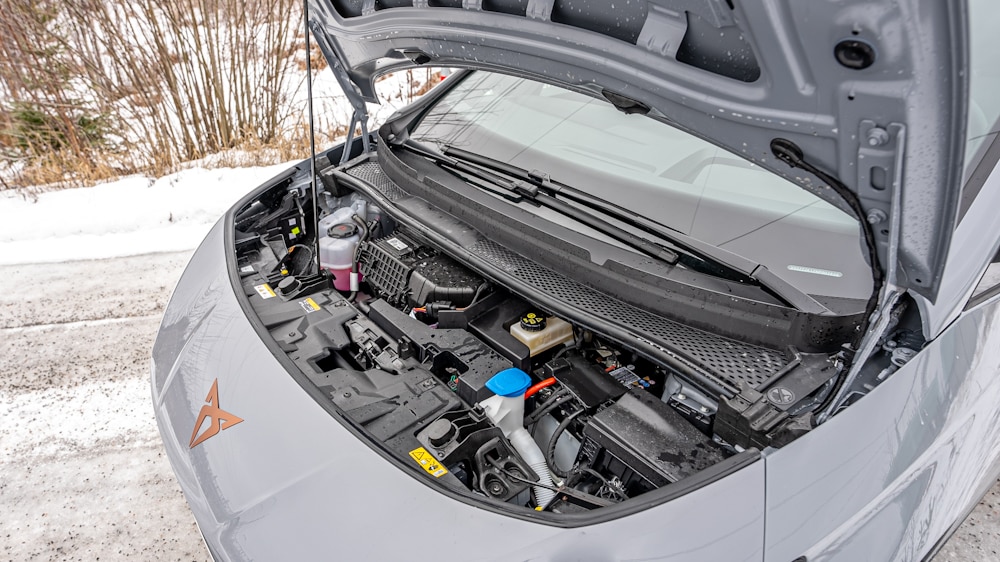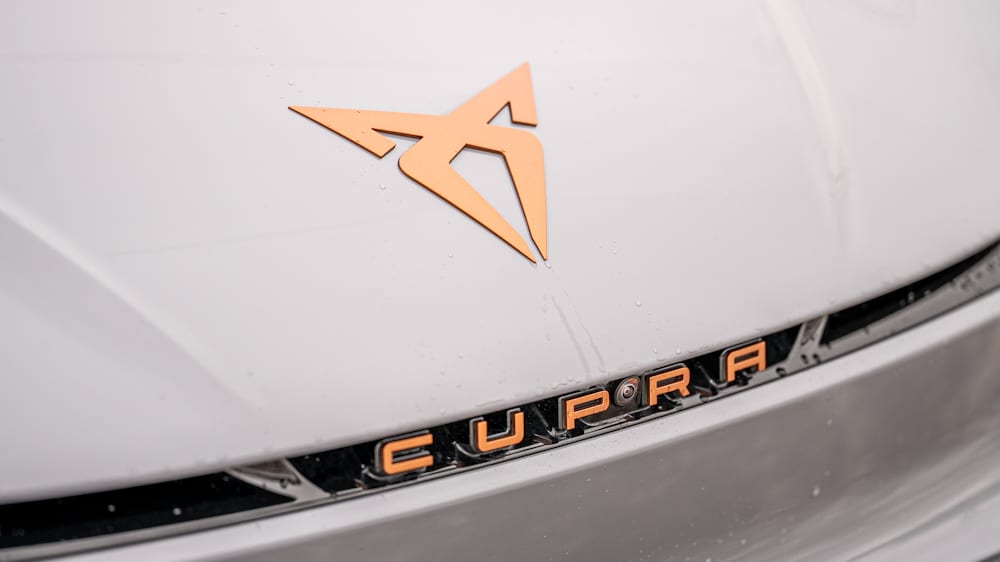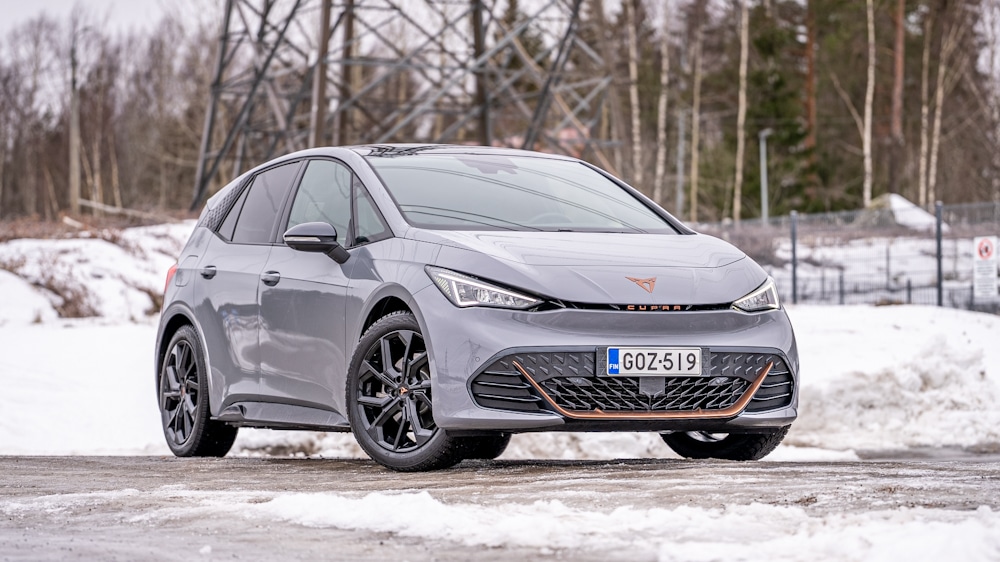The Cupra range is growing rapidly and the latest arrival, the all-electric Born, is generating excitement and expectations. Similar in design to its sister model ID.3, the Born clearly stands out on closer inspection, especially from the front and rear. The sporty design and Cupra’s signature copper-coloured details catch the eye inside and out.

In the Car of the Year 2022 final, the Born, which is aiming for the top prize, will compete against five other all-electric models. The Peugeot 308 is the only internal combustion engine model in the final.
Looks and feel
The Cupra Born and the Volkswagen ID.3, which roll off the same chassis and from the same factory, don’t need to be compared because of their branding, but the exterior cannot be ignored. While VW’s product looks very simple and unremarkable in places, the same cannot be said of Cupra’s.

Looking directly at the ID.3 from the side, the sibling relationship is obvious, but from the front and rear, the design and details communicate the sportiness of the Cupra brand. The copper-coloured details and the edginess of the design cannot be overlooked.
Strengths include not only a sporty exterior, but also a stiff and snappy ride. Compared to the ID.3, you wouldn’t think the cars shared the same genetic make-up.
the 19-inch friction tyres soften the roughness of winter roads – but the driving feel is still sporty. It’s easy to imagine what the Born is at its best on dry roads and summer tyres.

The Born may seem a bit too snappy for those looking for comfort and softness, but Cupra’s philosophy is not meant to please all customers. The buyer certainly knows what he wants, and the Born will not be a “one size fits all” profile.
The comfort, efficiency and delay-free nature of the electric powertrain make the driving experience simple and enjoyable. The rear-wheel-drive Born will surprise you with its effortlessness even in muddy conditions on roads filled with loose snow, thanks to the low centre of gravity provided by the batteries and its curb weight of around 1.8 tonnes. The Born is not to be confused with a traditional lightweight rear-wheel-drive internal combustion engine car for winter driving feel.
Charging performance was well below the promised
The 150 kW model with a 58 kWh net capacity battery is currently on the price list. The rear-wheel-drive Born has a good amount of power, even if it only takes 7.3 seconds from zero to 60 km/h. The immediate power, torque and rear-wheel drive make the car feel more efficient.

The Cupra promises an electricity consumption of 15.6 kWh/100 km. As expected, in winter conditions, the figures were not quite up to the manufacturer’s claims. On the road at an average speed of 100 km/h in zero wind conditions, consumption was 20.8 kWh/100 km. For 1,000 km, the trip computer showed an average consumption of 22.8 kWh/100 km. At the end of the test week, consumption was 23.9 kWh/100 km.
Based on these consumption figures, the vehicle can cover 278 kilometres on the motorway in chilly zero temperatures with a full battery and a range of around 250 kilometres in mixed driving. In summer weather, the range can be expected to improve by 50-100 km.

The Cupra promises a maximum charging power of 120 kW from a DC charger when the battery charge is below 30%. During the test drive, both power charging cycles fell far short of the promise, even though the battery charge was between 15-30% when the vehicle reached the charger.
Only 46 kW of maximum power was achieved, even though the charger was accessed at the end of a longer drive with a warm battery and a maximum charger power of 150 kW. This brings the advertised charging time of 35 minutes for fast charging to well over an hour.

The car can receive 11 kW from AC and home chargers, depending on the power of the charger. At its fastest, a full charge with an AC charger will therefore take just over 6 hours.
Practical interiors, slow infotainment
For a hatchback, the boot is a reasonable 385 litres. The boot is clearly laid out and the large tailgate makes loading easy. Under the floor of the boot you’ll find a shelf for things like charging cables or other small items. Under the bonnet, there is only a pee filler and the storage space frunk, familiar from many electric cars, is missing.

The interior design is clean and the familiar copper-coloured details from the exterior can also be enjoyed in the cabin. The driving position is made good by the rather sturdy seat, with adjustable thigh support for longer legs.
Between the seats there is storage space for drinks bottles and loose items. A wireless phone charging cradle is located in front of the elbow and partly underneath, where it is made challenging to look while driving. There’s room for three in the rear seats and legroom is comfortable thanks to the flat floor.
The commendably sized 12-inch media display is visually clear and informative, although it takes some time to get used to the menus. However, the user experience quickly takes a hit when loading the menus feels very slow and cumbersome at times.

The user experience of media systems is not improved by the haptic touch buttons on the steering wheel, which are difficult to understand at first. Some of the buttons on the steering wheel work with winter gloves on, others don’t.
The best feature of the media system is the parking heater menu, which allows the car to be automatically preheated for different days of the week at the desired time.

The Cupra Born, which has been selected as a finalist for Car of the Year 2022 along with six other cars, says a lot about the car’s features. We’ll see the outcome of the final race when the winner is announced at an online event on 28 February.

Cupra Born 150 kW 58 kWh
- Electric motor power: 150 kW. (204 hp.)
- Electric motor torque: 310 Nm.
- Acceleration: 7.3 sec. (0-100 km/h)
- Driving battery capacity (gross): 62 kWh.
- Driving battery capacity (net): 58 kWh.
- Manufacturer’s declared combined fuel consumption: 15.6 kWh/100km.
- Manufacturer’s declared range (combined): 421 km (WLTP)
- Consumption during test drive: 20-24 kWh/100km.
- Test-driven range on a single charge: 240-290 km.
- Maximum charging power (DC): 120 kW.
- Maximum charging power (AC): 11 kW.
- Total mass: 2260 kg.
- Cargo space: 385 l.
- Traction: rear-wheel drive
- Starting price: €42 390 (excl. €2000 purchase subsidy)










